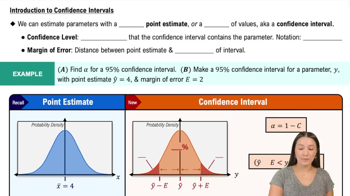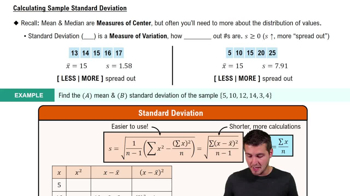Archeology Archeologists have studied sizes of Egyptian skulls in an attempt to determine whether breeding occurred between different cultures. Listed below are the widths (mm) of skulls from 150 A.D. (based on data from Ancient Races of the Thebaid by Thomson and Randall-Maciver). Construct a 99% confidence interval estimate of the mean skull width.
Table of contents
- 1. Intro to Stats and Collecting Data1h 14m
- 2. Describing Data with Tables and Graphs1h 55m
- 3. Describing Data Numerically2h 5m
- 4. Probability2h 16m
- 5. Binomial Distribution & Discrete Random Variables3h 6m
- 6. Normal Distribution and Continuous Random Variables2h 11m
- 7. Sampling Distributions & Confidence Intervals: Mean3h 23m
- Sampling Distribution of the Sample Mean and Central Limit Theorem19m
- Distribution of Sample Mean - Excel23m
- Introduction to Confidence Intervals15m
- Confidence Intervals for Population Mean1h 18m
- Determining the Minimum Sample Size Required12m
- Finding Probabilities and T Critical Values - Excel28m
- Confidence Intervals for Population Means - Excel25m
- 8. Sampling Distributions & Confidence Intervals: Proportion1h 12m
- 9. Hypothesis Testing for One Sample3h 29m
- 10. Hypothesis Testing for Two Samples4h 50m
- Two Proportions1h 13m
- Two Proportions Hypothesis Test - Excel28m
- Two Means - Unknown, Unequal Variance1h 3m
- Two Means - Unknown Variances Hypothesis Test - Excel12m
- Two Means - Unknown, Equal Variance15m
- Two Means - Unknown, Equal Variances Hypothesis Test - Excel9m
- Two Means - Known Variance12m
- Two Means - Sigma Known Hypothesis Test - Excel21m
- Two Means - Matched Pairs (Dependent Samples)42m
- Matched Pairs Hypothesis Test - Excel12m
- 11. Correlation1h 6m
- 12. Regression1h 50m
- 13. Chi-Square Tests & Goodness of Fit1h 57m
- 14. ANOVA1h 57m
7. Sampling Distributions & Confidence Intervals: Mean
Confidence Intervals for Population Mean
Problem 7.2.19
Textbook Question
Mercury in Sushi An FDA guideline is that the mercury in fish should be below 1 part per million (ppm). Listed below are the amounts of mercury (ppm) found in tuna sushi sampled at different stores in New York City. The study was sponsored by the New York Times, and the stores (in order) are D’Agostino, Eli’s Manhattan, Fairway, Food Emporium, Gourmet Garage, Grace’s Marketplace, and Whole Foods. Construct a 98% confidence interval estimate of the mean amount of mercury in the population. Does it appear that there is too much mercury in tuna sushi?
0.56 0.75 0.10 0.95 1.25 0.54 0.88
 Verified step by step guidance
Verified step by step guidance1
Step 1: Identify the given data and the requirements of the problem. The data provided are the mercury levels in ppm: 0.56, 0.75, 0.10, 0.95, 1.25, 0.54, and 0.88. The task is to construct a 98% confidence interval for the mean mercury level in the population and determine if the mean exceeds the FDA guideline of 1 ppm.
Step 2: Calculate the sample mean (\( \bar{x} \)) and the sample standard deviation (\( s \)). Use the formulas \( \bar{x} = \frac{\sum x_i}{n} \) for the mean and \( s = \sqrt{\frac{\sum (x_i - \bar{x})^2}{n-1}} \) for the standard deviation, where \( n \) is the sample size and \( x_i \) are the individual data points.
Step 3: Determine the critical value for a 98% confidence level. Since the sample size is small (n = 7) and the population standard deviation is unknown, use the t-distribution. Find the t-value corresponding to a 98% confidence level and degrees of freedom \( df = n - 1 \).
Step 4: Calculate the margin of error (ME) using the formula \( ME = t \cdot \frac{s}{\sqrt{n}} \), where \( t \) is the critical value, \( s \) is the sample standard deviation, and \( n \) is the sample size.
Step 5: Construct the confidence interval using the formula \( \text{Confidence Interval} = \bar{x} \pm ME \). Interpret the interval to determine if the mean mercury level in the population exceeds the FDA guideline of 1 ppm.
 Verified video answer for a similar problem:
Verified video answer for a similar problem:This video solution was recommended by our tutors as helpful for the problem above
Video duration:
4mPlay a video:
Was this helpful?
Key Concepts
Here are the essential concepts you must grasp in order to answer the question correctly.
Confidence Interval
A confidence interval is a range of values, derived from sample statistics, that is likely to contain the true population parameter with a specified level of confidence, such as 98%. It provides an estimate of uncertainty around the sample mean, allowing researchers to infer about the population mean. The wider the interval, the more uncertainty there is about the estimate.
Recommended video:

Introduction to Confidence Intervals
Mean and Standard Deviation
The mean is the average of a set of values, calculated by summing all values and dividing by the number of observations. The standard deviation measures the dispersion of the data points around the mean, indicating how spread out the values are. Together, these statistics are essential for constructing confidence intervals and understanding the data's variability.
Recommended video:
Guided course

Calculating Standard Deviation
Hypothesis Testing
Hypothesis testing is a statistical method used to determine whether there is enough evidence in a sample to support a specific claim about a population parameter. In this context, it involves testing whether the mean mercury level in tuna sushi exceeds the FDA guideline of 1 ppm. The results can help assess the safety of consuming tuna sushi based on the sample data.
Recommended video:
Guided course

Step 1: Write Hypotheses

 4:48m
4:48mWatch next
Master Population Standard Deviation Known with a bite sized video explanation from Patrick
Start learningRelated Videos
Related Practice
Textbook Question
